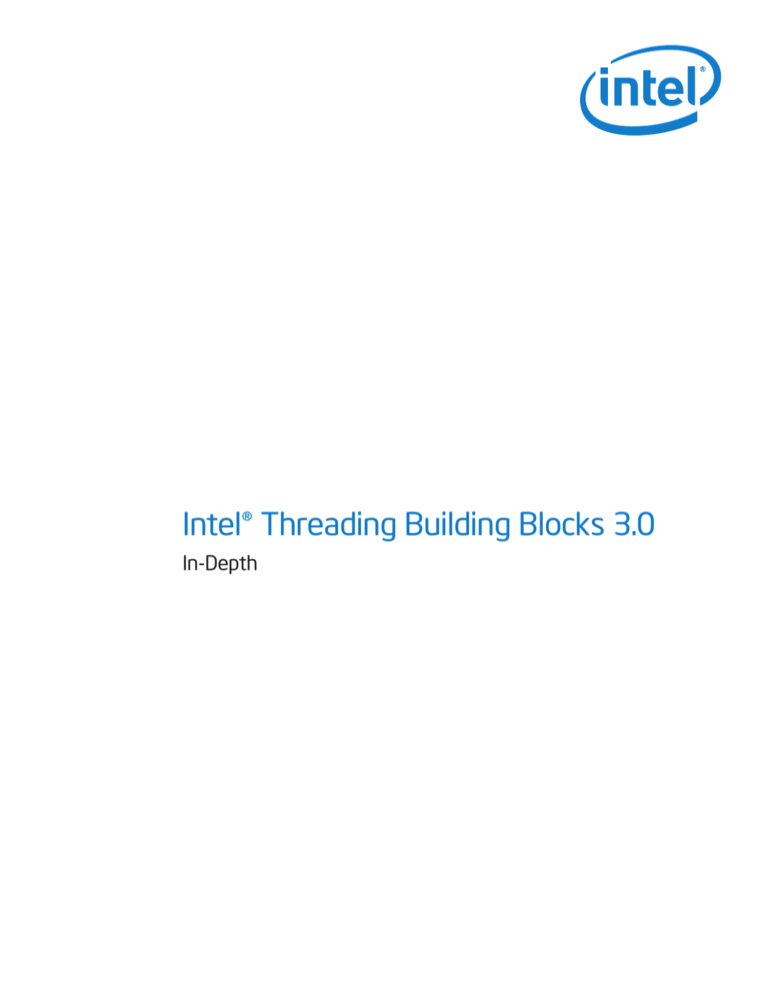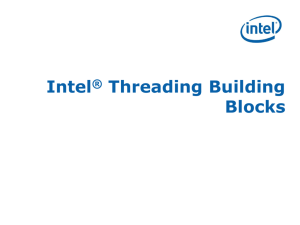
Intel® Threading Building Blocks 3.0
In-Depth
Intel® Threading Building Blocks 3.0
Contents
Intel® Threading Building Blocks 3.0. . . . . . . . . . . . . . . . . . . . . . . . 3
Features . . . . . . . . . . . . . . . . . . . . . . . . . . . . . . . . . . . . . . . . . . . . . . . . . 4
What’s New in Intel TBB 3.0. . . . . . . . . . . . . . . . . . . . . . . . . . . . . . . 5
Technical Support . . . . . . . . . . . . . . . . . . . . . . . . . . . . . . . . . . . . . . . . 6
Which Intel TBB License Is Right for Your Needs?. . . . . . . . . . . 6
2
Intel® Threading Building Blocks 3.0
Intel® Threading Building Blocks (Intel® TBB) 3.0
Everything You Expect in Parallel Application Design—
Portability, Scalability, Reliability, Simplicity
Intel® Threading Building Blocks 3.0 (Intel® TBB) is an award-winning C++ template library that abstracts threads to tasks to create reliable,
portable, and scalable parallel applications. Use Intel TBB for a simple
and rapid way of developing robust task-based parallel applications
that scale to available processor cores, are compatible with multiple
Comprehensive—Intel TBB provides a suite of components that help
simplify and speed development of scalable, high performance parallel
applications. It provides parallel algorithms, concurrent containers,
task scheduling, scalable memory allocation, and synchronization
primitives. In addition, the runtime library provides an optimal-size
thread pool; task granularity and performance-oriented scheduling;
automatic load balancing through task stealing; and cache efficiency
and memory reuse.
environments, and easier to maintain code. Intel TBB is the most
Future-proof Applications—Application performance automatically
proficient way to design future-proof parallel applications that
improves as processor core count increases by using abstract tasks.
tap into the power and performance of multicore and manycore
Sophisticated task scheduler dynamically maps tasks to threads to
hardware platforms.
balance the load among available cores, preserve cache locality, and
Enhanced Productivity—Intel TBB uses task-based abstractions
maximize parallel performance.
that make it easier to get scalable and reliable parallel applications
Performance Advantage—Optimized for scalable multicore
with fewer lines of code. Task-based algorithms, containers, and
architectures including Non-Uniform Memory Access (NUMA), Intel
synchronization primitives simplify parallel application development.
TBB delivers higher-performing and reliable code with less effort than
Portability—Intel TBB is validated and commercially supported
hand threading.
on Windows*, Linux*, and Mac OS* platforms. It is also available on
FreeBSD*, IA Solaris*, XBox* 360, and PowerPC-based systems via the open source community. Organizations can expand their customer
base by using a production-ready, open solution for parallelism that is available on a broad range of platforms.
Intel® Threading Building Blocks v3.0
Generic Parallel Algorithms
Concurrent Containers
Task Scheduler
•parallel_for(range)
•parallel_reduce
•parallel_for_each(begin, end)
•parallel_do
•parallel_invoke
•pipeline
•parallel_pipeline
•parallel_sort
•parallel_scan
•concurrent_hash_map
•concurrent_queue
•concurrent_bounded_queue
•concurrent_vector
•concurrent_unordered_map
•task_group
•structured_task_group
•task_scheduler_init
•task_scheduler_observer
Synchronization Primitives
Memory Allocation
•atomic
•mutex
•recursive_mutex
•spin_mutex
•spin_rw_mutex
•queuing_mutex
•queuing_rw_mutex
•reader_writer_lock
•critical_section
•condition_variable
•null_mutex
•null_rw_mutex
•tbb_allocator
•cache_aligned_allocator
•scalable_allocator
•zero_allocator
Thread Local Storage
Threads
Miscellaneous
•enumerable_thread_specific
•combinable
•thread
•tick_count
•captured_exception
•moveable_exception
Figure 1. Intel TBB offers comprehensive, abstracted templates, containers, and classes for parallelism. Version 3.0 expands usage models and
improves performance and usability. Italic text in table means “new function”.
3
Intel® Threading Building Blocks 3.0
Features
Intel TBB offers comprehensive, abstracted templates; containers;
and classes for parallelism. Version 3.0 expands usage models and
improves performance and usability. Figure 1 highlights the major
functional groups within Intel TBB 3.0. Be sure to go to the What’s
New in 3.0 section on threadingbuildingblocks.org for a more detailed
description of the new capabilities within Intel TBB 3.0.
Intel TBB lets developers focus on adding value to their application
instead of thread management. Figure 2 highlights a dramatically
simpler multithreaded implementation with Intel TBB versus native
threads. Intel TBB utilizes robust functions that reduce threading
errors like deadlock and race conditions.
Order the Intel® TBB book at: http://www.amazon.com/IntelThreading-Building-Blocks-Parallelism/dp/0596514808/ref=pd_bbs_s
r_1?ie=UTF8&s=books&qid=1215536190&sr=1-1
Figure 2. Side-by-side comparison of equivalent Windows* thread
functionality that requires significantly more code to make a 2D ray
tracing program, Tachyon, correctly threaded. Linux* and Mac OS X*
developers can expect similar results.
4
Intel® Threading Building Blocks 3.0
LEGEND:
Compiler:
Intel TBB:
Hardware:
OS:
Intel® C++ Compiler 11.1 for applications running on Intel® 64, Build 20090827 Package ID: l_cproc_p_11.1.056
3.0 RTM
4 * Intel® Xeon® CPU X7560 @ 2.27GHz (32 cores), 192GB Main Memory
Linux, Red Hat* Enterprise Server* release 5.4, kernel 2.6.18-164.el5, glibc 2.5
Disclaimer: Performance tests and ratings are measured using specific computer systems and/or components and reflect the approximate performance of Intel products as measured by those
tests. Any difference in system hardware or software design or configuration may affect actual performance. Buyers should consult other sources of information to evaluate the performance
of systems or components they are considering purchasing. For more information on performance tests and on the performance of Intel products, refer to http://www.intel.com/performance/
resources/benchmark_limitations.htm *Other brands and names are the property of their respective owners.
Figure 3.Excellent scalability and improved performance using Intel TBB versus a serial implementation. Windows and Mac OS X developers can expect
similar results.
What’s New in Intel TBB 3.0—More Compatibility,
Performance, Tasks, and Classes
Extended Compatibility—More Choices, Interoperability, and
Enhanced Parallel Application Performance on
Compatibility Support:
Multicore Processors
• MicrosoftVisualStudio2010*ParallelPatternsLibrary(PPL)
• MemoryAllocatorincludesadditionaloptimizationsforlarge
andConcurrencyRuntime(ConcRT)compatibilityand
interoperabilitysupport
blocks(>8KB)
Expanded Use Cases, Classes, and Functions—Added
• MicrosoftWindows7*support
Interoperability and Capabilities:
• AppleMacOSX*SnowLeopard*support
• Expandedlambdassupport—improvedpipeline,addedfunction
Enhanced Task Scheduler Features—More Predictable and
Expanded Task Functions
• Starvation-proofschedulingtasksforqueue-likework
• MasterThreadIsolation
• Taskgroupcontextcannowbecreatedanddestroyedin
differentthreads
5
parallel_pipelineastronglytypedlambda-friendlyinterfacefor
buildingandrunningpipelines
• NewC++0xConditionVariable
• Newconcurrent_unordered_map
Improved Documentation—More Examples
• AddednewDesignPatternsdocumentationthatarticulatesusage
modelsandcommonpatterns
“The Maya team has successfully used Intel’s TBB
technology to internally parallelize Maya for several releases. Now thanks to Intel, TBB lets Maya plugin developers access the same advanced parallelism
features that we’ve used at no additional charge.” Gordon Bradley,
Maya Performance Team Lead
“Bringing Intel into the Integrated Partners Program
and integrating TBB into Unreal Engine 3* ensures our
licensees are within reach of the best development tools
available,” said Dr. Michael Capps, president of Epic
Games. “This partnership will help minimize the work
required to author multithreaded applications for Unrealpowered games and, in the long term, provide developers
with greater access to Intel® Tools.”
“The Intel® TBB malloc was an important tool in achieving
good parallel speedups for our threaded applications,
and a drop-in replacement for the memory allocator in
the C standard library.” Ron Henderson,
R&D FX Manager
DreamWorks Animation
Technical Support
Intel® Software Development Product purchases may include a year of support services, which provide access to Intel® Premier
Support and all product updates during that time. Intel Premier
Support gives you online access to technical notes, application notes, and documentation.
Which Intel TBB License Is Right for Your Needs?
Intel TBB is available commercially as a binary distribution, and in
open source in both source and binary forms. If you need commercial
support services you should purchase either a standalone commercial
license or take advantage of the considerable value in purchasing the
Intel® Parallel Studio or Intel® Compiler Professional Edition. If your
legal counsel is comfortable with your use of software under the Intel
TBB open source license and you do not require commercial support
services, please download the latest version of open source Intel
TBB (threadingbuildingblocks.org). Finally, if you require the ability to
modify or distribute the commercial source code of TBB, contact your
Intel representative for more information.
When built from source, Intel TBB is intended to be highly portable,
and so it supports a wide variety of operating systems and platforms.
Binary distributions, including commercial distributions, are validated
and officially supported for a variety of select hardware, software,
operating systems, and compilers.
© 2010, Intel Corporation. All rights reserved. Intel, the Intel logo, and Intel Xeon are trademarks of Intel Corporation in the U.S. and other countries.
*Other names and brands may be claimed as the property of others.
0410/BLA/CMD/PDF
321517-001








